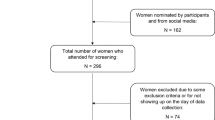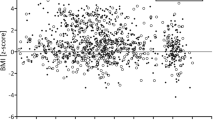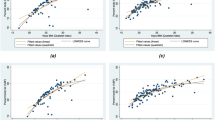Abstract
Background/Objectives:
To compare the characteristics of body composition for different gender and age in a large number of apparently healthy Chinese subjects, and to determine reference values for fat-free mass index (FFMI) and fat mass index (FMI).
Subjects/Methods:
In total, 61 382 Chinese adults (age range: 18–92 years) were consecutively enrolled into the study. Body composition was measured using bioelectrical impedance analysis with a tetrapolar impedance meter.
Results:
The skeletal muscle mass, fat-free mass (FFM), FFMI and body mass index (BMI) were significantly higher in men than in women (P<0.05), but FM% and FMI were significantly higher in women (P<0.05). In the group with normal BMI (BMI 18.5–23.9 kg/m2, 18–92 years), the reference values (5th–95th percentile) of FM%, FFMI and FMI were 9.7–34.5%, 14.15–19.76 and 1.99–7.75 kg/m2 in men, and 18.1–35.8%, 13.82–17.89 and 3.68–8.16 kg/m2 in women, respectively.
Conclusions:
Reference intervals for FFMI and FMI could be of practical value for the clinical evaluation of a deficit in FFM with or without excess FM for a given age category, complementing the classical concept of BMI in a more qualitative manner, although these indices are only suggestive indications for the degree of obesity. In contrast to BMI, similar reference ranges of FFMI seem to be more utilizable with advancing age.
This is a preview of subscription content, access via your institution
Access options
Subscribe to this journal
Receive 12 print issues and online access
$259.00 per year
only $21.58 per issue
Buy this article
- Purchase on Springer Link
- Instant access to full article PDF
Prices may be subject to local taxes which are calculated during checkout
Similar content being viewed by others
References
Deurenberg P . Universal cut-off BMI points for obesity are not appropriate. Br J Nutr 2001; 85: 135–136.
Kyle UG, Genton LC, Slosman DO, Pichard C . Fat-free and fat mass percentiles in 5225 healthy subjects aged 15 to 98 years. Nutrition 2001; 17: 534–541.
Lee CD, Blair SN, Jackson AS . Cardiorespiratory fitness, body composition, and all-cause and cardiovascular disease mortality in men. Am J Clin Nutr 1999; 69: 373–380.
Engelen MPKJ, Schols AMWJ, Lamers RJS, Wouters EFM . Different patterns of chronic tissue wasting among patients with chronic obstructive pulmonary disease. Clin Nutr 1999; 18: 275–280.
Heber D, Ingles S, Ashley JM, Maxwell MH, Lyons RF, Elashoff RM . Clinical detection of sarcopenic obesity by bioelectrical impedance analysis. Am J Clin Nutr 1996; 64: 472S–477S.
Baumgartner RN, Koehler KM, Gallagher D, Romero L, Heymsfield SB, Ross RR et al. Epidemiology of sarcopenia among the elderly in New Mexico. Am J Epidemiol 1998; 147: 755–763.
Van Itallie TB, Yang M-U, Heymsfield SB, Funk RC, Boileau R . Height-normalized indices of the body's fat-free mass and fat mass: potentially useful indicators of nutritional status. Am J Clin Nutr 1990; 52: 953–959.
Dey DK, Bosaeus I, Lissner L, Steen B . Body composition estimated by bioelectrical impedance in the Swedish elderly. Development of population based prediction equation and reference values of fat-free mass and body fat for 70- and 75-y olds. Eur J Clin Nutr 2003; 57: 909–916.
Kyle UG, Bosaeus I, De Lorenzo AD, Deurenberg P, Elia M, Gomez JM et al. Bioelectrical impedance analysis–part I: review of principles and methods. Clin Nutr 2004; 23: 1226–1243.
Kyle UG, Bosaeus I, De Lorenzo AD, Deurenberg P, Elia M, Gomez JM et al. Bioelectrical impedance analysis-part II: utilization in clinical practice. Clin Nutr 2004; 23: 1430–1433.
Deurenberg P, Schutz Y . Body composition: overview of methods and future directions of research. Ann Nutr Metab 1995; 39: 325–333.
Deurenberg P, Weststrate JA, van der Kooy K . Body composition changes assessed by bioelectrical impedance measurements. Am J Clin Nutr 1989; 49: 401.
Gray DS . Changes in bioelectrical impedance during fasting. Am J Clin Nutr 1988; 48: 1184–1187.
Kushner RF, Schoeller DA . Estimation of total body water by biolectrical impedance analysis. Am J Clin Nutr 1986; 44: 417–424.
Lukaski HC . Assessment of fat-free mass using bioelectrical impedance measurements of the human body. Am J Clin Nutr 1985; 41: 810–817.
Jackson AS, Pollock ML, Graces JE, Mahar MT . Reliability and validity of bioelectrical impedance in determining body composition. J Appl Physiol 1988; 64: 529–534.
Kyle UG, Genton L, Karsegard L, Slosman DO, Pichard C . Single prediction equation for bioelectrical impedance analysis in adults aged 20–94 y. Nutrition 2001; 17: 248–253.
Baumgartner RN . Body composition in healthy aging. Ann NY Acad Sci 2000; 904: 437–448.
Bartlett HL, Puhl SM, Hodgson JL, Buskirk ER . Fat-free mass in relation to stature: ratios of fat-free mass to height in children, adults, and elderly subjects. Am J Clin Nutr 1991; 53: 1112–1116.
Baarends EM, Schols AMWS, van Marten Lichtenbelt WD, Wouters EFM . Analysis of body water compartments in relation to tissue depletion in clinically stable patients with chronic obstructive pulmonary disease. Am J Clin Nutr 1997; 65: 88–94.
Deurenberg-Yap M, Schmidt G, van Staveren WA, Deurenberg P . The paradox of low body mass index and high body fat percentage among Chinese, Malays and Indians in Singapore. Int J Obes Relat Metab Disord 2000; 24: 1011–1017.
Schutz Y, Kyle U, Pichard C . Fat-free mass index and fat mass index percentiles in Caucasians aged 18–98 y. Int J Obes 2002; 26: 953–960.
Pichard C, Kyle UG, Bracco D, Slosman DO, Morabia A, Schutz Y . Reference values of fat-free and fat masses by bioelectrical impedance analysis in 3393 healthy subjects. Nutrition 2000; 16: 245–254.
Author information
Authors and Affiliations
Corresponding authors
Ethics declarations
Competing interests
The authors declare no conflict of interest.
Rights and permissions
About this article
Cite this article
Lu, Y., Shu, H., Zheng, Y. et al. Comparison of fat-free mass index and fat mass index in Chinese adults. Eur J Clin Nutr 66, 1004–1007 (2012). https://doi.org/10.1038/ejcn.2012.86
Received:
Revised:
Accepted:
Published:
Issue Date:
DOI: https://doi.org/10.1038/ejcn.2012.86
Keywords
This article is cited by
-
Changes in chronotype and social jetlag during adolescence and their association with concurrent changes in BMI-SDS and body composition, in the DONALD Study
European Journal of Clinical Nutrition (2022)
-
Does FMI Correlate Better than BMI with the Occurrence of Metabolic Changes in Obese Patients? Study Based on 2007 Consecutive Mexican Patients
Obesity Surgery (2020)
-
Body composition, water turnover and physical activity among women in Narok County, Kenya
BMC Public Health (2014)
-
Influence of age and gender on fat mass, fat-free mass and skeletal muscle mass among Australian adults: The Australian diabetes, obesity and lifestyle study (AusDiab)
The Journal of nutrition, health and aging (2014)



